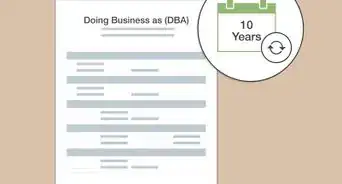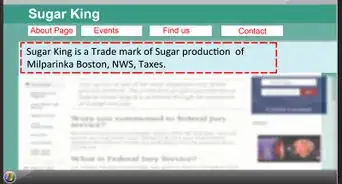This article was co-authored by Clinton M. Sandvick, JD, PhD. Clinton M. Sandvick worked as a civil litigator in California for over 7 years. He received his JD from the University of Wisconsin-Madison in 1998 and his PhD in American History from the University of Oregon in 2013.
There are 8 references cited in this article, which can be found at the bottom of the page.
This article has been viewed 32,440 times.
In order to form a limited liability company (LLC) in the State of Texas, you will need to understand the legal procedure for business formation in Texas. There is a very specific path that must be taken in order to form an LLC, requiring a number of forms and tax filings that apply to both in-state and out-of-state entities wishing to do business in Texas. Knowing how to form an LLC can help you protect your investments and grow your business in the State of Texas.
Steps
Planning Your LLC
-
1Determine your member structure. An LLC is somewhat flexible in terms of who can be considered a part of the company. Legally speaking, an LLC's owners (called "members") may be a single individual, a partnership between two or more people, a corporation, a trust, or any other legal entity capable of operating a business.[1]
- If you have legal or business experience, sufficient capital, and believe you could feasibly run the LLC yourself, then you may wish to form the company as an individual. If not, consider forming a partnership with one or more individuals, or any of the other qualifying legal entities.
-
2Choose an entity name. Once you know who your LLC's members will be, you'll need to choose a name for the entity. There are some specific guidelines that determine what can and cannot be used as the entity name. When naming your LLC, you should be aware of the following guidelines:
- The name may not be identical or remotely similar to any existing entity name that has been filed, either domestically or outside the state.[2]
- The name may not include any letters or numerals that cannot be typed on a standard English keyboard. Acceptable numerals include zero through 9, in any combination. Acceptable symbols for use in the name include ! " $ % ' ( ) * ? # = @ [ ] / + & and -.
- The entity name may not be deceptive or imply any false government affiliation or endorsement. The name is also prohibited from implying any unlawful activity or business dealings which the registered entity is not permitted to conduct.
- No name may be used which is deemed to be "grossly offensive." The Office of the Secretary of State has the final say on all name approvals or denials, and may deem a name to be offensive or otherwise inappropriate.
- Your entity name must contain the words "Limited Liability Company" or an appropriate abbreviation, including LLC or L.L.C. You must use the LLC or Limited Liability Company with your entity's name each time you list or identify the entity.[3]
Advertisement -
3Verify and reserve your name. Before you can register your LLC, you will need to ensure that the name you've chosen has not been taken already. You can do this by cross-checking your desired name with the Texas Secretary of State SOSDirect website at http://www.sos.state.tx.us/corp/sosda/. You may also want to reserve your name (pending approval) until you've completed all of the necessary steps to form and register your company. You can reserve your company's name through the SOSDirect website at http://www.sos.state.tx.us/corp/sosda/.[4]
- You can verify your name by calling the Secretary of State office at (512) 463-5555, then dialing 7-1-1 for relay services. You can also verify your name via e-mail by sending your inquiry to corpinfo@sos.state.tx.us.[5]
- Reservations can be made online 24 hours a day through the SOSDirect website.[6] You can also fax your reservation and forms to the Secretary of State's office at (512) 463-5709.[7]
- The reservation period lasts 120 days. If you need to renew your reservation, you may do so within the 30-day period before your reservation expires. There is no limit to the number of times a reservation may be renewed.[8]
- Each reservation must include a filing fee of $40.[9]
Registering Your Company
-
1Select a registered agent. Before you can file to form your LLC, you will need to name a registered agent for your company. The primary role of the registered agent is to accept any and all legal documents served to the company. The registered agent must be either an individual resident of the State of Texas (who maintains a physical residence in the state), or an entity (domestic or foreign) that is registered to conduct business in the State of Texas.[10]
- The LLC may not be its own registered agent within the State of Texas.[11]
- The registered agent must give written or electronic consent to the LLC's members. The written consent does not need to be submitted with the certificate of formation, but it is required for the company's records. Failure to secure a written or electronic consent of the registered agent will subject the LLC's members to the liabilities and penalties associated with filing a false statement, as the company is deemed to have named that agent without the individual's consent.[12]
-
2Designate a registered office. In addition to naming a registered agent for the company, you must also designate a registered company office. The office must have a valid, listed address where service of process may be delivered to the LLC's registered agent during the course of normal business hours. It must be a physical office location, meaning a mailbox service or telephone answering service may not be designated as the registered office.[13]
- The registered office does not have to be the registered agent's primary place of business, but it must meet the requirements of being a physical office in which the agent conducts relevant work.[14]
- If your LLC is registered in another state and you wish to do business in Texas, you must complete Form L0011, the Application for Registration of Firm Office. This form must be completed and submitted for the LLC's main office in Texas before the company can be registered and licensed. You can find Form L0011 online at http://www.tsbpa.state.tx.us/pdffiles/l0011.pdf.[15]
-
3File a Certificate of Formation. The State of Texas requires you to complete and file Form 205, the Certificate of Formation Limited Liability Company. You can find that form on the Secretary of State website at http://www.sos.state.tx.us/corp/forms/205_boc.pdf. The form will require you to provide the name of your LLC, the registered agent and office, and the name and address of any designated managers of the LLC (if your LLC will have managers).[16] You may also have to file Form L0014: Peer Review Reporting, which can be found online at http://www.tsbpa.state.tx.us/pdffiles/l0014.pdf.[17]
- There is a $300 filing fee that must be paid to the Texas Secretary of State when you file your LLC's Certificate of Formation. Checks or money orders must be made payable to the Texas Secretary of State. If you are paying with a credit card, your payment will be subject to a convenience fee of 2.7 percent of the total fee - approximately $8.10, unless there are any additional fees required.[18]
- You can submit a duplicate copy of the form and the filing fee to the state, either by fax, through the mail, or in person.[19]
- The form can be faxed to (512) 463-5709, and must include valid credit card information with the fax transmission.[20]
- The form can be mailed to P.O. Box 13697 - Austin, Texas 78711-3697.[21]
- If you live in or near Austin, you can deliver the form in person to the James Earl Rudder Office Building at 1019 Brazos Street, Austin, Texas 78701.[22]
-
4Consider drafting an operating agreement. Though you are not required to write or file an operating agreement to form an LLC in Texas, some legal experts recommend drafting an operating agreement anyway to simplify the company's operations.[23] There is no absolute rule for what an operating agreement should include, but it typically lists how the company is/will be managed, how meetings are conducted, how much capital each member is required to contribute, and how the LLC will manage its profits and losses.[24]
-
5Obtain a local license. In addition to filing to form an LLC, you may need to obtain a basic business license, LLC license, and/or a tax registration certificate. The necessary license(s) will be obtained from the city or county in which your company is registered. Not every local government requires an LLC to obtain a local business license, but many do. Contact your county or city clerk's office to determine whether you will need a local business license, and to inquire about any related fees.[25]
- The local license(s) must be renewed on an annual basis.[26]
Meeting Financial Requirements
-
1Request an IRS Employer Identification Number (EIN). You must request an EIN if there are more than one members in the LLC (even if you do not have any employees hired at the LLC), or if a single-member LLC has any employees hired by the company.[27] You can do this online through the IRS website at https://www.irs.gov/Businesses/Small-Businesses-&-Self-Employed/Apply-for-an-Employer-Identification-Number-(EIN)-Online.[28]
-
2Determine your tax obligations. Any business with one or more employees in the State of Texas is subject to state employment taxes. You will need to inform both the State of Texas and the Internal Revenue Service (IRS) of any hirings you make. Your company will also be subject to the state's franchise tax.[29]
- Register your business with the Texas Employer Portal at https://portal.cs.oag.state.tx.us/wps/portal/AccountRequest. This is where you will also report any employee hirings or terminations.[30]
- The Texas franchise tax requires all LLCs in the state to pay either 0.25 percent of the company's annual capital or 4.5 percent of the company's earned surplus, whichever is greater.[31]
- LLCs are exempt from the state franchise tax if the LLC owes less than $100 in taxes, or if the gross receipts from the company's taxable capital and taxable earned surplus are each under $150,000 in a given tax period.[32]
-
3Open a business bank account. Even if you are operating an LLC as the sole member, it is still important to separate your business's finances from your own personal finances. In order to open a business bank account, you will most likely need your IRS Employer Identification Number, a copy of your filed Certificate of Formation, and some documentation identifying any authorized signers whose names are not listed on the Certificate of Formation.[33]
References
- ↑ http://www.sos.state.tx.us/corp/businessstructure.shtml
- ↑ http://www.sos.state.tx.us/corp/forms/205_boc.pdf
- ↑ http://www.tsbpa.state.tx.us/pdffiles/l0016.pdf
- ↑ http://www.sos.state.tx.us/corp/namefilingsfaqs.shtml#namereservations
- ↑ http://www.dmlp.org/legal-guide/forming-llc-texas
- ↑ http://www.sos.state.tx.us/corp/namefilingsfaqs.shtml#namereservations
- ↑ http://www.sos.state.tx.us/corp/options.shtml
- ↑ http://www.sos.state.tx.us/corp/namefilingsfaqs.shtml#namereservations
- ↑ http://www.nolo.com/legal-encyclopedia/texas-form-llc-31745.html
- ↑ http://www.sos.state.tx.us/corp/forms/205_boc.pdf
- ↑ http://www.nolo.com/legal-encyclopedia/texas-form-llc-31745.html
- ↑ http://www.sos.state.tx.us/corp/forms/205_boc.pdf
- ↑ http://www.sos.state.tx.us/corp/forms/205_boc.pdf
- ↑ http://www.sos.state.tx.us/corp/forms/205_boc.pdf
- ↑ http://www.tsbpa.state.tx.us/pdffiles/l0016.pdf
- ↑ http://www.sos.state.tx.us/corp/forms/205_boc.pdf
- ↑ http://www.tsbpa.state.tx.us/pdffiles/l0016.pdf
- ↑ http://www.sos.state.tx.us/corp/forms/205_boc.pdf
- ↑ http://www.sos.state.tx.us/corp/forms/205_boc.pdf
- ↑ http://www.sos.state.tx.us/corp/forms/205_boc.pdf
- ↑ http://www.sos.state.tx.us/corp/forms/205_boc.pdf
- ↑ http://www.sos.state.tx.us/corp/forms/205_boc.pdf
- ↑ http://www.dmlp.org/legal-guide/forming-llc-texas
- ↑ http://www.dmlp.org/legal-guide/forming-llc-texas
- ↑ http://www.dmlp.org/legal-guide/forming-llc
- ↑ http://www.tsbpa.state.tx.us/pdffiles/l0016.pdf
- ↑ http://www.nolo.com/legal-encyclopedia/texas-form-llc-31745.html
- ↑ http://www.dmlp.org/legal-guide/forming-llc-texas
- ↑ http://www.dmlp.org/legal-guide/forming-llc-texas
- ↑ http://www.dmlp.org/legal-guide/forming-llc-texas
- ↑ http://www.dmlp.org/legal-guide/forming-llc-texas
- ↑ http://www.dmlp.org/legal-guide/forming-llc-texas
- ↑ http://www.dmlp.org/legal-guide/forming-llc-texas
-Step-5-Version-2.webp)



-Step-1-Version-2.webp)








-in-the-USA-Step-20.webp)














-in-the-USA-Step-20.webp)




































